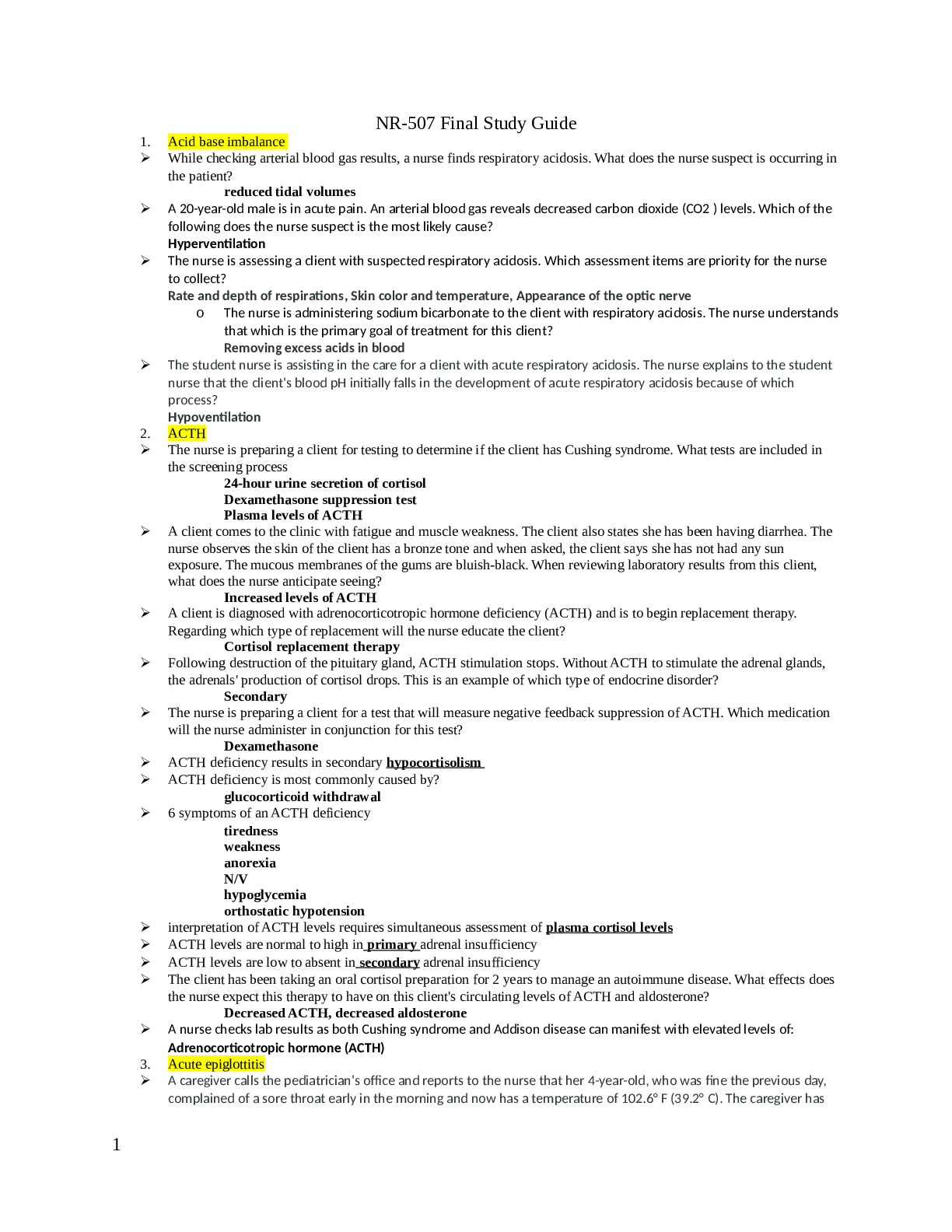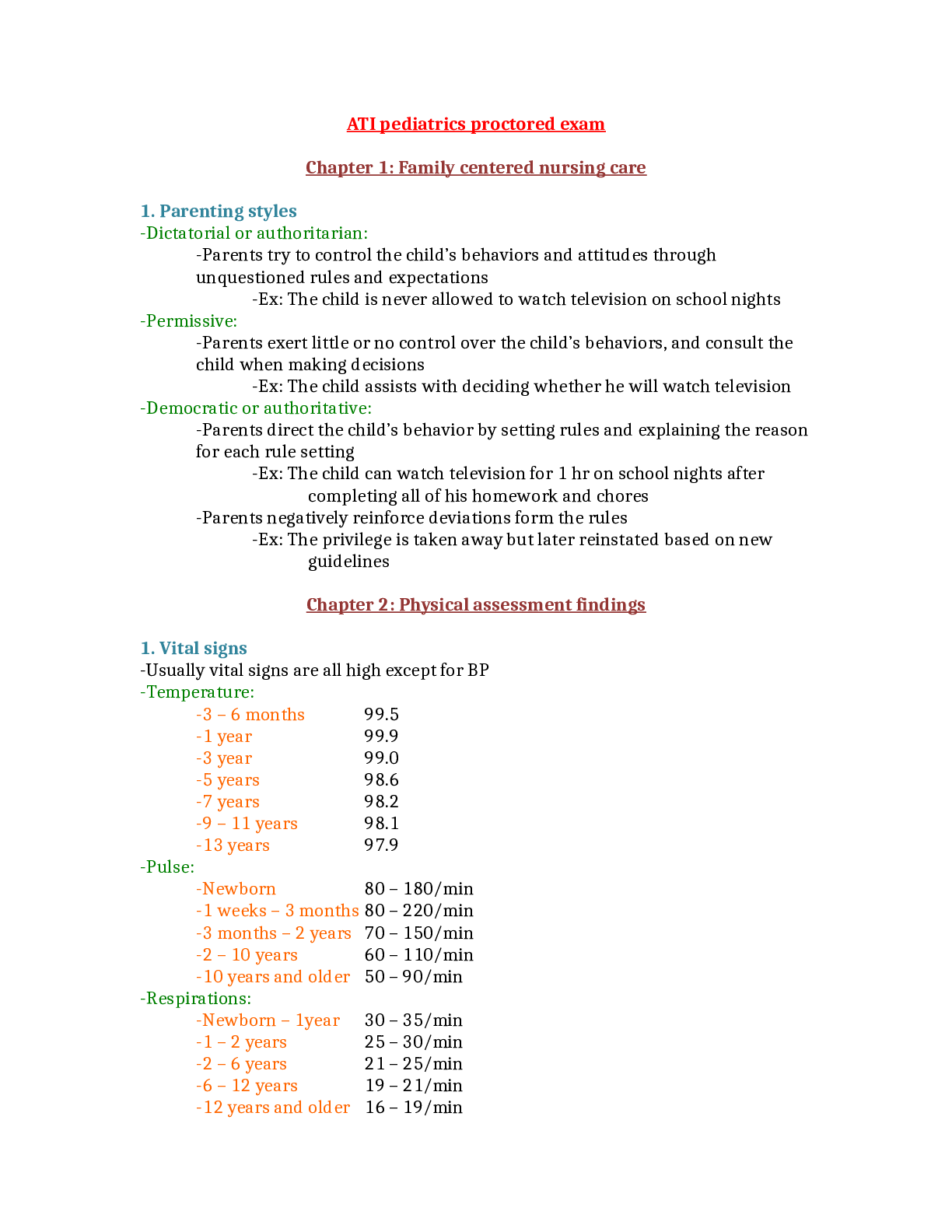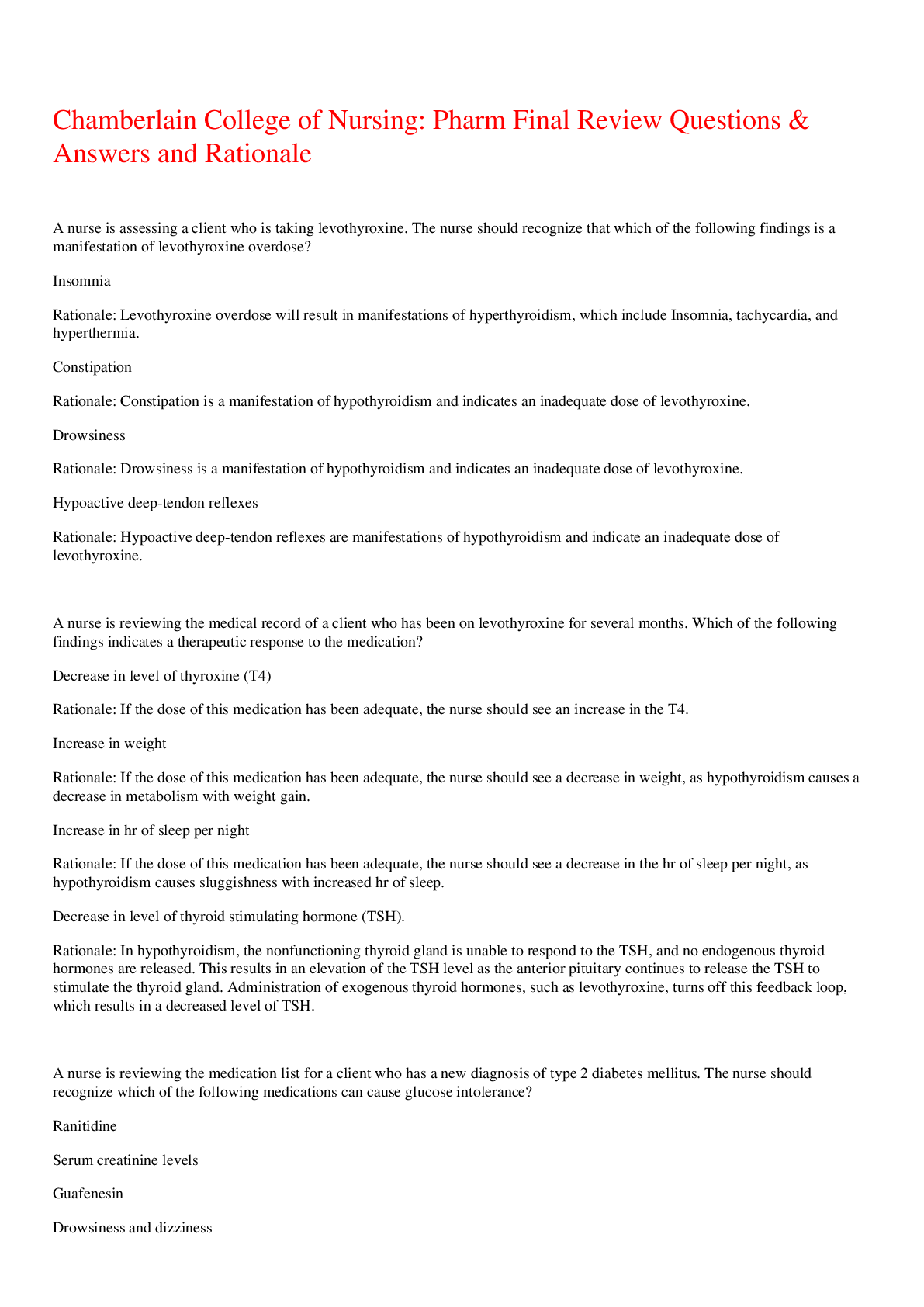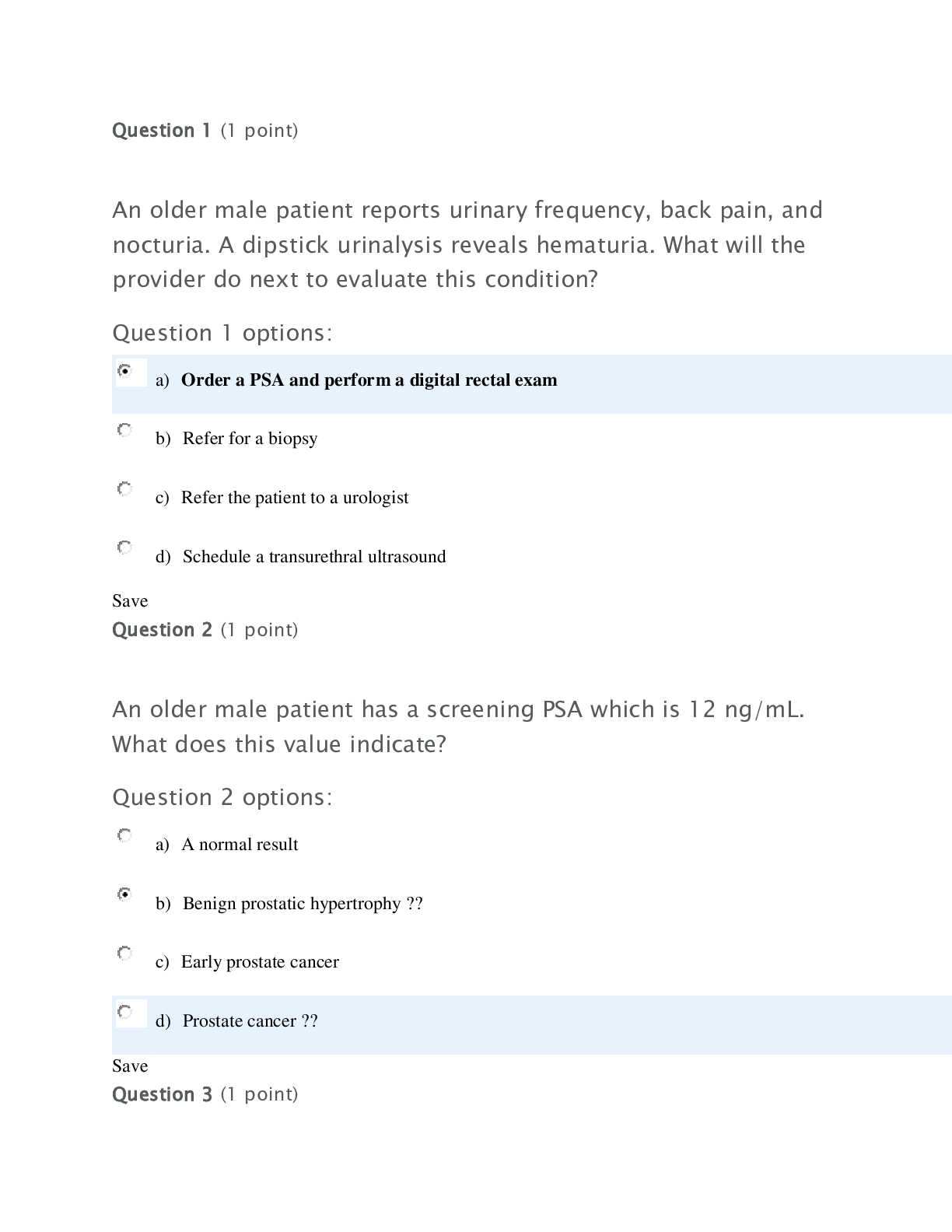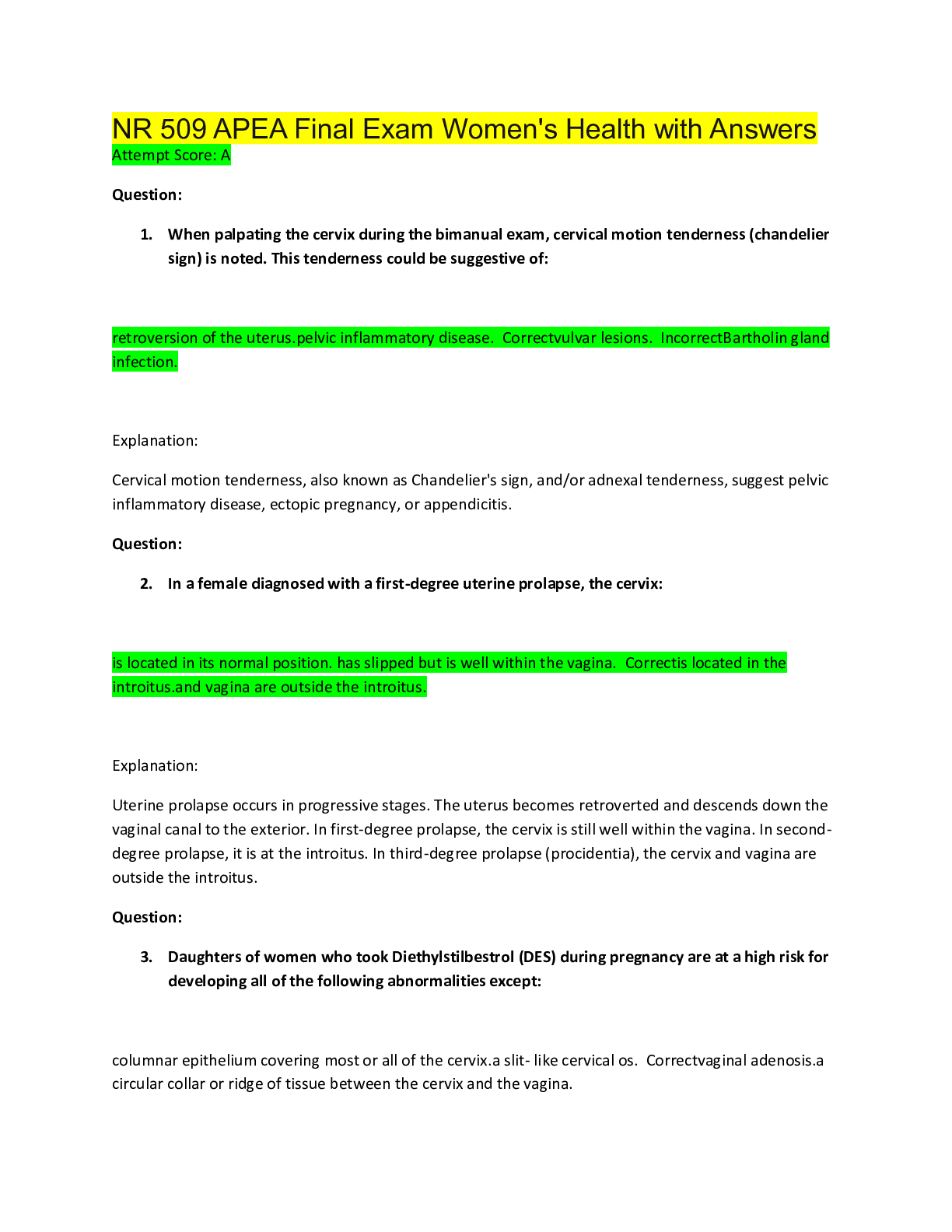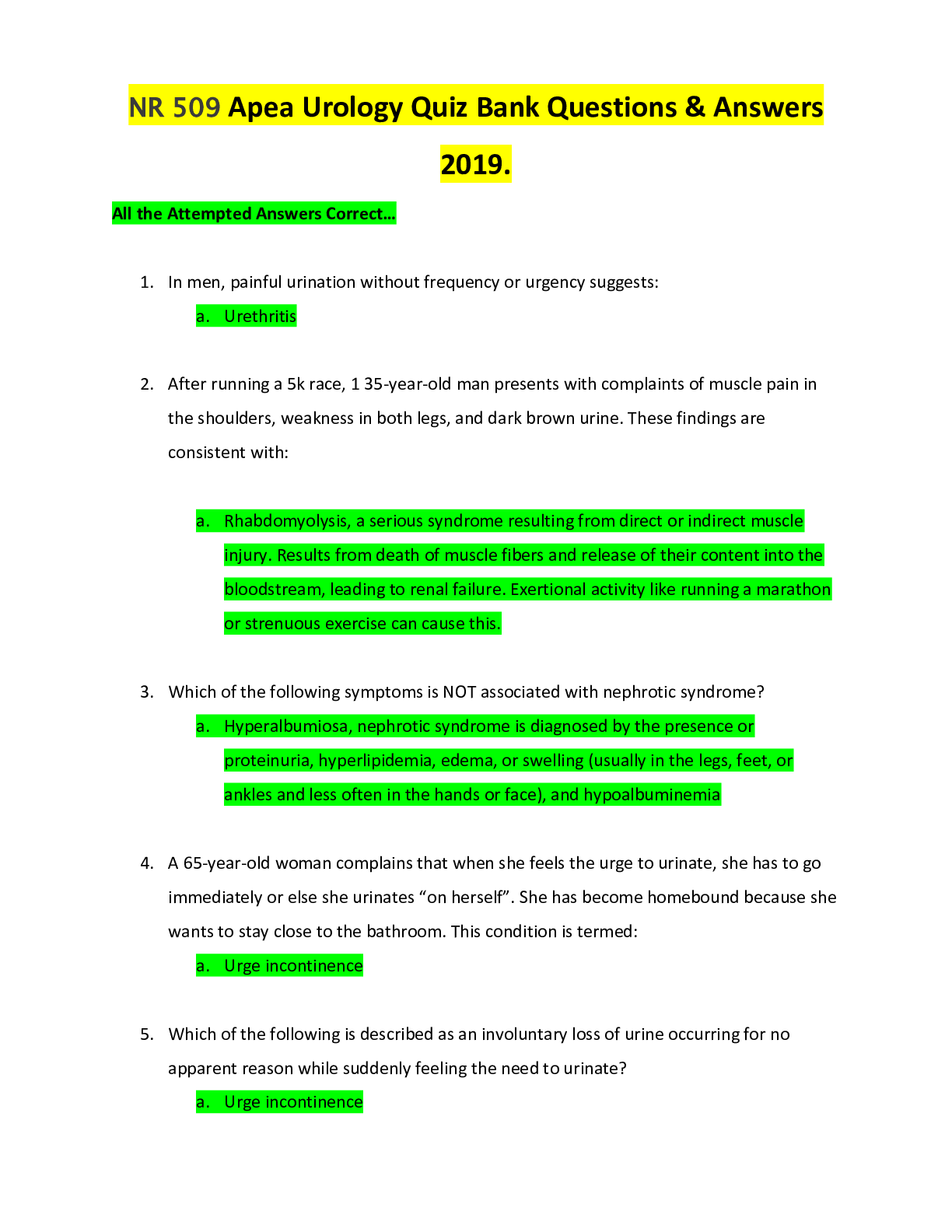*NURSING > EXAM > NUR 265 Exam 3 ENDOCRINE Questions – Galen College of Nursing | NUR265 Exam 3 ENDOCRINE Questions (All)
NUR 265 Exam 3 ENDOCRINE Questions – Galen College of Nursing | NUR265 Exam 3 ENDOCRINE Questions LATEST FOR 2021/2022
Document Content and Description Below
NUR 265 Exam 3 ENDOCRINE Questions – Galen College of Nursing MEDSURG 2 Exam 3 ENDOCRINE 1) A client is admitted to the ICU with diagnosis of a brain tumor complicated by transient diabetes insipidu... s. Which client data related to this complication should the nurse expect? Select all that apply. 1. Dark, amber urine with sediment 2. High serum osmolality 3. Low urine specific gravity 4. Recent weight gain 5. Reports of excessive thirst 2) A hospitalized patient is diagnosed with a pheochromocytoma, a tumor of the adrenal medulla. Which clinical manifestation should the nurse expect to observe? 1. Elevated H&H 2. Hypertension 3. Hypoglycemia 4. Weight gain. 3) The nurse is assessing a patient with hypoparathyroidism for electrolyte imbalances. The nurse notes a positive Chvostek’s sign, indicating: 1. Hypercalcemia 2. Hyperphosphatemia 3. Hypocalcemia 4. Hypophosphatemia 4) A patient is seen in the ER after abruptly discontinuing her thyroid medication. She is hypotensive ve, hypoglycemic, and is unresponsive. This clinical picture is most common with: 1. Hypertensive crisis 2. Myxedema coma 3. Thyroid cancer 4. Thyroid storm 5) The nurse is assessing a patient admitted with SIADH. Which assessment finding suggests this condition? 1. Hypotension 2. Increased urine output 3. Jugular vein distension (JVD) 4. Weight loss 6) The nurse is performing her routine physical assessment on a patient with Cushing’s syndrome. Which of the following assessment findings is the nurse most likely to discover? 1. Adipose deposits in the face and back 2. Cardiac arrhythmias from hyperkalemia 3. Dizziness from hypotension 4. Shakiness and sweating from hypoglycemia 7) The nurse reviews a patient’s lab results, noting a blood glucose level of 895 mg/dl. The patient is most likely experiencing which acid-base imbalance? 1. Metabolic acidosis 2. Metabolic alkalosis 3. Respiratory acidosis 4. Respiratory alkalosis 8) The nurse is caring for a patient scheduled for a radioactive iodine uptake test. Which of the following statements should be included in the patient instructions? 1. “A small dose of IV radioactive iodine will be administered after the test.” 2. “Minimize contact with others to avoid radioactive contamination.” 3. “Take special precautions when urinating, such as flushing the toilet at least twice.” 4. “The procedure tests the rate of iodine excretion.” 9) The nurse is treating a patient suffering from an Addisonian crisis. The nurse should avoid the administration of: 1. Dextrose 2. Hydrocortisone 3. Potassium Chloride 4. Vasopressor 10) The nurse caring for a critical patient with hypoparathyroidism. Which of the following complications should the nurse be alert for in a patient with severe hyposecretion of the parathyroid hormone? 1. Encephalopathy 2. Hypertensive crisis 3. Renal failure 4. Seizures 11) The nurse is assigned to care for a client who had a thyroidectomy 24 hours ago. On initial assessment which finding requires the most immediate action by the nurse? 1. Calcium 8.8 mg/dL 2. Heart rate 100/minute 3. Laryngeal stridor 4. Pain rated 8 out of 10. 12) The nurse in ICU cares for a client with adrenocortical insufficiency (Addison’s) disease. The client reports nausea and abdominal pain. The blood pressure suddenly drops from 120/74 to 88/48, HR increases from 80 to 100/min and the client appears confused. Which action should the nurse take first? 1. Administer as-needed dose of hydrocortisone IVP 2. Complete a head-to-toe assessment to identify any sources of infection. 3. Document the findings in the clients electronic medical record 4. Take blood pressure sitting and standing to assess orthostatic hypotension. 13) The nurse cares for a client with Addison’s disease who was involved in a motor vehicle accident and hospitalized for a fracture of the right femur. Which client information is most important to report to the PCP? 1. B/P change from 128/80 mm Hg to 90/50 mm Hg 2. Development of first degree atrioventricular block on electrocardiogram (ECG) 3. Report of right femur pain of 7 out of 10 4. Vesicular breath sounds auscultated over the lung tissue 14) The nurse is caring for a client with a closed traumatic brain injury and suspects that the client is developing diabetes insipidus (DI). Which of the following findings would be consistent with this diagnosis? A. An increase in the blood glucose level from 89 mg/dL to 187 mg/dL B. An increase in blood pressure from 98/66 mm Hg to 126/78 mm Hg. C. A decrease in deep tendon reflexes from 3+ to 2+. D. A decrease in specific gravity from 1.010 to 1.001. 15) The nurse is reviewing newly prescribed medications for assigned clients. Which of the following prescribed medications should the nurse question? A. Methimazole for a client who has developed thyroid storm. B. Furosemide for a client who has hyperparathyroidism. C. Desmopressin IV for a client who has SIADH. D. Hydrocortisone sodium succinate IV for a client who has developed Addisonian crisis. 16) The nurse is caring for a client who has lung cancer and has developed syndrome of inappropriate antidiuretic hormone secretion (SIADH). Which of the following would be an expected finding? A. Serum sodium level of 118 mEq/L. B. Hematocrit level of 54%. C. Report by the client of increased thirst. D. Blood urea nitrogen (BUN) level of 31 mg/dL. 17) The nurse is caring for a client who has developed SIADH. It would be necessary for the nurse to immediately notify the primary health care provider (PHCP) if the client A. Has 2+ pitting edema of the lower extremities B. Gained 1.5 pounds in the past 24 hours C. Drank 500 mL of water at lunch. D. Developed crackles in the bases of the lungs. 18) The nurse is caring for a client who has adrenal insufficiency. Which of the following medications should the nurse expect to be prescribed for the client? A. Spironolactone. B. Furosemide. C. Vasopressin. D. Prednisone. 19) The nurse is caring for a client who has adrenal insufficiency and is experiencing an exacerbation. Which of the following nursing actions should the nurse incorporate into the client’s plan of care? A. Assist the client to stand up slowly. B. Keep the lights in the client’s room dim. C. Maintain the client on a low sodium diet. D. Monitor the client’s blood glucose for hyperglycemia. 20) The nurse is assessing clients for their risk of developing Cushing’s syndrome. The nurse should identify at greatest risk, the client who is a A. 44-year-old female and has been taking corticosteroids for 10 years to treat rheumatoid arthritis. B. 55-year-old male and was recently diagnosed with a pheochromocytoma. C. 33-year-old female, has a goiter, and is receiving supplemental iodine (SSKI). D. 22-year-old male, and recently had an adrenalectomy. 21) The nurse is caring for a client who was admitted with a pheochromocytoma. Which of the following nursing actions would be a priority? A. Continuous monitoring of the client’s oxygen saturation. B. Encourage the client to use the incentive spirometer every hour. C. Maintaining a strict record of the client’s intake and output. D. Frequent monitoring of the client’s blood pressure. 22) The nurse is instructing a client who has suspected Graves’ disease and is scheduled to have a radioactive iodine uptake (RAIU) test. Which of the following client statements would indicate a correct understanding about this test? A. “This test is being performed to destroy some of the cells that produce thyroid hormone. B. “I will need to use a separate bathroom for two weeks after this test is performed.” C. “This test is being performed to determine how well my thyroid gland functions.” D. “I will need to stay away from my grandchild for 48 hours after this test is performed.” 23) The nurse is assessing a client who has hyperthyroidism and is at risk for developing thyroid storm. It would be necessary for the nurse to notify the primary health care provider (PHCP) if the client A. reports having a sensitivity to light. B. has an increase in temperature from 98.6⁰ F to 100.8⁰ F. C. Voided 500 mL in the past four hours. D. has had a blood pressure of 118/62 mm Hg for the past four hours. 24) The nurse has instructed a client who has hyperthyroidism and been prescribed propylthiouracil. Which of the following client statements would indicate a correct understanding of the teaching? A. “I will need to use an electric razor because this medication will cause me to bleed much easier." B. “I need to observe my urine and notify my doctor if I notice that it is becoming dark in color. C. “I will need to have my blood sugar monitored while taking this medication.” D. “I should increase my foods containing iron while taking this medication.” 25) The nurse is caring for a client who has undergone a subtotal thyroidectomy. Which of the following should the nurse include in the client’s plan of care? A. Encourage the client to avoid coughing for 72 hours following surgery. B. Instruct the client to rest in bed with the neck slightly extended. C. Keep a tracheotomy set at the client’s bedside. D. Monitor the client for evidence of an elevated calcium level. 26) The nurse is assessing a client who has suspected hypothyroidism. Which of the following findings is consistent with this diagnosis? A. Impaired memory. B. Diaphoresis C. Exophthalmos. D. Low-grade fever. 27) The home health nurse is visiting a client who has hypothyroidism and was recently started on levothyroxine. It would be a priority for the nurse to assess the client’s A. skin turgor and oral temperature. B. neurological status and activity level. C. bowel sounds and last reported bowel movement. D. heart rate and blood pressure. 28) The nurse has become aware of the following client situations. It would be a priority for the nurse to follow up with the client who A. has SIADH and continues to have a sodium level of 119 mEq/L. B. had a subtotal thyroidectomy 12 hours ago and is reporting that the dressing now feels tight. C. is newly diagnosed with hyperthyroidism and has an apical heart rate of 110 beats per minute. D. has diabetes insipidus (DI) and received the first dose of prescribed vasopressin thirty minutes ago. 29) The nurse is caring for a client with suspected hypoparathryoidism. Which of the following would be an expected finding? A. Muscle weakness B. Hypermagnesemia C. Constipation D. Hypocalcemia. 30) The nurse working on a surgical unit has been made aware of the following client situations. The nurse should first see the client who had a A. thyroidectomy 24 hours ago and has a serum calcium level of 8.5 mg/dL. B. thyroidectomy six hours ago and has not voided since surgery. C. transsphenoidal hypophysectomy 12 hours ago and is asking for a tissue in order to blow their nose. D. transsphenoidal hypophysectomy 8 hours ago and has been performing deep breathing exercises without coughing 31) The nurse is providing care to a client who has hypoparathyroidism and has developed a positive Trousseau’s sign and reports tingling of the hands and lips. Which of the following actions should the nurse be prepared to take? A. Implement seizure precautions for the client. B. Encourage the client to increase the intake of milk and yogurt. C. Monitor the client’s serum potassium levels. D. Continuously monitor the client’s oxygen saturation level. 32) The nurse is caring for a client who is receiving treatment for DKA. Which of the following laboratory values would indicate that the client’s DKA is resolving? A. A glycosylated hemoglobin (HgbA1C) level of 6.0%. B. A urine specific gravity of 1.000. C. A blood glucose level of 190 mg/dL and a HCO3- of 21 mEq/L. D. A blood pH of 7.30 and a serum potassium level of 4.9 mEq/L 33) The nurse is providing discharge teaching to a client with type 1 diabetes mellitus about ‘sick day’ rules, and ways to prevent the development of diabetic ketoacidosis (DKA). It would indicate a correct understanding of the teaching if the client states A. “I will test my urine ketones if my blood sugar becomes greater than 240 mg/dL.” B. “I will change my eating pattern to eat six small meals throughout the day.” C. “I will monitor my blood glucose level two times a day when I am sick.” D. “I will not take my insulin if I am unable to eat due to nausea or vomiting.” 34) The nurse is developing a plan of care for a client with type 1 diabetes mellitus who is being admitted with DKA and influenza. Which of the following should the nurse recognize as the priority intervention? A. Monitoring the client’s urine glucose level. B. Determining the client’s knowledge about ‘sick day’ rules. C. Obtaining a prescription for sodium bicarbonate to correct the acid-base imbalance D. Decreasing the client’s blood glucose level 50-75 mg/dL/hr. 35) The nurse is admitting a client who has hyperglycemic-hyperosmolar state (HHS). Which of the following assessment findings is consistent with this diagnosis? A. Positive ketones in the urine. B. A blood sugar of 820 mg/dL. C. A serum pH of 7.29 D. Kussmaul respirations. 36) The nurse is caring for a client who requires treatment for hyperglycemic-hyperosmolar state (HHS). Which of the following interventions should the nurse be prepared to implement first? A. Monitor the client’s arterial blood gas (ABG) results. B. Administer prescribed insulin to the client. C. Administer prescribed intravenous fluids to the client D. Monitor the client’s potassium level. 37) The nurse is preparing to administer a regular insulin IV bolus to a client who has hyperglycemic-hyperosmolar state (HHS). The primary health care provider (PHCP) has prescribed an initial bolus dose of 0.1 unit/kg. The client weighs 198 pounds. How much regular insulin should the nurse administer to the client as an IV bolus? A. 15 units B. 12 units C. 9 units. D. 18 unit 38) The nurse is caring for a client who has hyperglycemic-hyperosmolar state (HHS) and is receiving a continuous IV infusion of regular insulin. It would require immediate follow up if the client has a A. serum sodium level of 148 mEq/L and a urine specific gravity of 1.036. B. decrease in the serum potassium level from 4.9 mEq/L to 4.2 mEq/L in the past four hours. C. decrease in blood sugar from 580 mg/dL to 350 mg/dL in the past hour. D. blood urea nitrogen (BUN) level of 32 mg/dL and a creatinine level of 1.8 mg/dL 39) The nurse is reviewing prescriptions for newly admitted clients. It would require immediate follow up by the nurse if the primary health care provider (PHCP) prescribes A. a glycosylated hemoglobin (HgbA1C) level for a client admitted with DKA. B. 3% NaCl at 100 mL/hr for a client receiving treatment for hyperglycemic-hyperosmolar state (HHS). C. a fluid restriction of 500-600 mL/24 hours for a client who has SIADH. D. a 24-hour urine collection for vanillylmandelic acid (VMA) for a client with a suspected pheochromocytoma. 40) The nurse is ware of the following client situations. The nurse should first follow up with the client who A. has pneumonia with atelectasis and has had decreased breath sounds in the affected lobe. B. has type 1 diabetes mellitus and has a blood glucose level of 228 mg/dL one hour before eating lunch. C. is receiving treatment for diabetic ketoacidosis (DKA) and has developed muscle weakness. D. has active pulmonary tuberculosis (TB) and is not wearing a surgical mask when a visitor is in the room. 41) The nurse is reviewing assessment data for the following clients. It would require immediate follow up by the nurse if a client A. had removal of a pheochromocytoma three days ago, and has had a bpof 132/74 and a HR of 92 for the past four hours. B. has type 2 diabetes mellitus and has a morning blood glucose level of 72 mg/dL, and does not want to eat breakfast. C. has hypothyroidism and has a temperature of 97.4⁰F and is reports having difficulty remembering things. D. had an adrenalectomy 24 hours ago and has a sodium level of 121 mEq/L, a bp of 94/60, and is restless. 42) A client with SIADH is admitted with a serum sodium level of 105 mEq/L. Which request by the health care provider does the nurse address first? A. Administer infusion of 150 mL of 3% NaCl over 3 hours. B. Draw blood for hemoglobin and hematocrit. C. Insert retention catheter and monitor urine output. D. Weigh the client on admission and daily thereafter. 43) How does the drug desmopressin (DDAVP) decrease urine output in a client with diabetes insipidus (DI)? A. Blocks reabsorption of sodium B. Increases blood pressure C. Increases cardiac output D. Works as an antidiuretic hormone (ADH) in the kidneys 44) A client presents to the ED with a history of adrenal insufficiency. The following laboratory values are obtained: Na+ 130 mEq/L, K+ 5.6 mEq/L, and glucose 72 mg/dL. Which is the first request that the nurse anticipates? A. Administer insulin and dextrose in normal saline to shift potassium into cells. B. Give spironolactone (Aldactone) 100 mg orally. C. Initiate histamine2 (H2) blocker therapy with ranitidine for ulcer prophylaxis. D. Obtain arterial blood gases to assess for peaked T waves. 45) A client with DI has dry lips and mucous membranes and poor skin turgor. Which intervention does the nurse provide first? A. Force fluids B. Offer lip balm C. Perform a 24-hour urine test D. Withhold desmopressin acetate (DDAVP) 46) A client with pheochromocytoma is admitted for surgery. What does the nurse do for the admitting assessment? A. Avoids palpating the abdomen B. Monitors for pulmonary edema with a chest x-ray C. Obtains a 24-hour urine specimen on admission D. Places the client in a room with a roommate for distraction 47) These data are obtained by the RN who is assessing a client who had a transsphenoidal hypophysectomy yesterday. What information has the most immediate implications for the client’s care? A. Dry lips and oral mucosa on examination B. Nasal drainage that tests negative for glucose C. Client report of a headache and stiff neck D. Urine specific gravity of 1.016 48) A client has undergone a transsphenoidal hypophysectomy. Which intervention does the nurse implement to avoid increasing ICP in the client? A. Encourages the client to cough and deep-breathe B. Instructs the client not to strain during a bowel movement C. Instructs the client to blow the nose for postnasal drip D. Places the client in the Trendelenburg position 49) The nurse is teaching a client about how to monitor therapy effectiveness for SIADH. What does the nurse tell the client to look for? A. Daily weight gain of less than 2 pounds B. Dry mucous membranes C. Increasing heart rate D. Muscle spasms 50) Which laboratory result indicates that fluid restrictions have been effective in treating SIADH? A. Decreased hematocrit B. Decreased serum osmolality C. Increased serum sodium D. Increased urine specific gravity 51) A client presents to the ED with acute adrenal insufficiency and the following vital signs: P 118 beats/min, R 18 breaths/min, BP 84/44 mm Hg, pulse oximetry 98%, and T 98.8° F oral. Which nursing intervention is the highest priority for this client? A. Administering furosemide (Lasix) B. Providing isotonic fluids C. Replacing potassium losses D. Restricting sodium 52) A client with a possible adrenal gland tumor is admitted for testing and treatment. Which nursing action is most appropriate for the charge nurse to delegate to the nursing assistant? A. Assess skin turgor and mucous membranes for hydration status. B. Discuss the dietary restrictions needed for 24-hour urine testing. C. Plan ways to control the environment that will avoid stimulating the client. D. Remind the client to avoid drinking coffee and changing position suddenly. 53) Which action does the PACU nurse perform first when caring for a client who has just arrived after a total thyroidectomy? A. Assess the wound dressing for bleeding. B. Give morphine sulfate 4 to 8 mg IV for pain. C. Monitor oxygen saturation using pulse oximetry. D. Support the head and neck with sandbags. 54) The RN has just received change-of-shift report on the med-surg unit. Which client will need to be assessed first? A. Client with Hashimoto’s thyroiditis and a large goiter B. Client with hypothyroidism and an apical pulse of 51 beats/min C. Client with parathyroid adenoma and flank pain due to a kidney stone D. Client who had a parathyroidectomy yesterday and has muscle twitching 55) What effect can starting a dose of levothyroxine too high or increasing a dose too rapidly have on a client? A. Bradycardia and decreased level of consciousness B. Decreased respiratory rate C. Hypotension and shock D. Hypertension and heart failure 56) A client is taking methimazole (Tapazole) for hyperthyroidism and would like to know how soon this medication will begin working. What is the nurse’s best response? A. “You should see effects of this medication immediately.” B. “You should see effects of this medication within 1 week.” C. “You should see full effects from this medication within 1 to 2 days.” D. “You should see some effects of this medication within 2 weeks.” 57) The nurse reviews the vital signs of a client diagnosed with Graves’ disease and sees that the client’s temperature is up to 99.6° F. After notifying the health care provider, what does the nurse do next? A. Administers acetaminophen B. Alerts the Rapid Response Team C. Asks any visitors to leave D. Assesses the client’s cardiac status completely 58) A client being treated for hyperthyroidism calls the home health nurse and mentions that his heart rate is slower than usual. What is the nurse’s best response? A. Advise the client to go to a calming environment. B. Ask whether the client has increased cold sensitivity or weight gain. C. Instruct the client to see his health care provider immediately. D. Tell the client to check his pulse again and call back later. 59) A client had a parathyroidectomy 18 hours ago. Which finding requires immediate attention? A. Edema at the surgical site B. Hoarseness C. Pain on moving the head D. Sore throat 60) A client recently admitted with hyperparathyroidism has a very high urine output. What does the nurse do first? A. Calls the health care provider B. Monitors intake and output C. Performs an immediate cardiac assessment D. Slows the rate of IV fluids 61) A client with hyperaldosteronism is being treated with spironolactone (Aldactone) before surgery. Which precautions does the nurse teach this client? A. “Read the label before using salt substitutes.” B. “Do not add salt to your food when you eat.” C. “Avoid exposure to sunlight.” D. “Take Tylenol instead of aspirin for pain.” 62) The nurse is preparing the room for the client returning from a thyroidectomy. Which items are important for the nurse to have available for this client? (Select all that apply.) A. Calcium gluconate B. Emergency tracheotomy kit C. Furosemide (Lasix) D. Hypertonic saline E. Oxygen F. Suction 63) A nurse cares for a client who possibly has syndrome of inappropriate antidiuretic hormone (SIADH). The client’s serum sodium level is 114 mEq/L. Which action should the nurse take first? A. Consult with the dietitian about increased dietary sodium. B. Restrict the client’s fluid intake to 600 mL/day. C. Handle the client gently by using turn sheets for re-positioning. D. Instruct unlicensed assistive personnel to measure intake and output. 64) A nurse evaluates the following laboratory results for a client who has hypoparathyroidism: Calcium 7.2 mg/dL Sodium 144 mEq/L Magnesium 1.2 mEq/L Potassium 5.7 mEq/L Based on these results, which medications should the nurse anticipate administering? (Select all that apply.) A. Oral potassium chloride B. Intravenous calcium chloride C. 3% normal saline IV solution D. 50% magnesium sulfate E. Oral calcitriol (Rocaltrol) 65) A nurse cares for a client with elevated triiodothyronine and thyroxine, and normal thyroid-stimulating hormone levels. Which actions should the nurse take? (Select all that apply.) A. Administer levothyroxine (Synthroid). B. Monitor the apical pulse. C. Assess for Trousseau’s sign. D. Initiate telemetry monitoring. 66) 2. A patient is admitted with Diabetic Ketoacidosis. The physician orders intravenous fluids of 0.9% Normal Saline and 10 units of intravenous regular insulin IV bolus and then to start an insulin drip per protocol. The patient’s labs are the following: pH 7.25, Glucose 455, potassium 2.5. Which of the following is the most appropriate nursing intervention to perform next? A. Start the IV fluids and administer the insulin bolus and drip as ordered B. Hold the insulin and notify the doctor of the potassium level of 2.5 C. Hold IV fluids and administer insulin as ordered D. Recheck the glucose level 67) Which patient is MOST likely to develop Diabetic Ketoacidosis? A. A 25 year old female newly diagnosed with Cushing’s Disease taking glucocorticoids. B. A 36 year old male with diabetes mellitus who has been unable to eat the past 2 days due to a gastrointestinal illness and has not been taking insulin. C. A 35 year old female newly diagnosed with Type 2 diabetes. D. None of the options are correct. [Show More]
Last updated: 1 year ago
Preview 1 out of 12 pages
Instant download
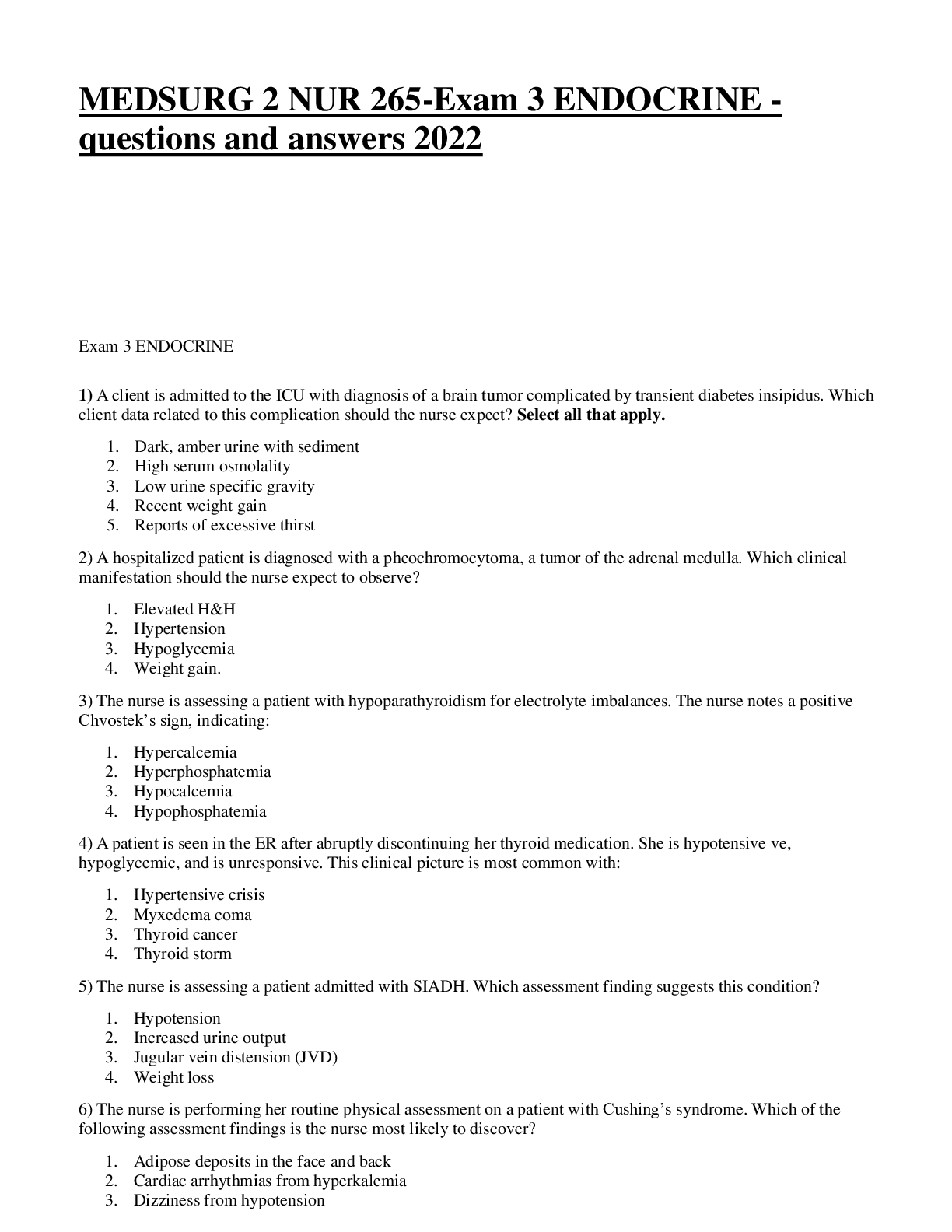
Buy this document to get the full access instantly
Instant Download Access after purchase
Add to cartInstant download
Reviews( 0 )
Document information
Connected school, study & course
About the document
Uploaded On
Aug 04, 2021
Number of pages
12
Written in
Additional information
This document has been written for:
Uploaded
Aug 04, 2021
Downloads
0
Views
48


 Complete solutions.png)


 NURS 3247Pharmacology - Proctored Assessment,.png)

